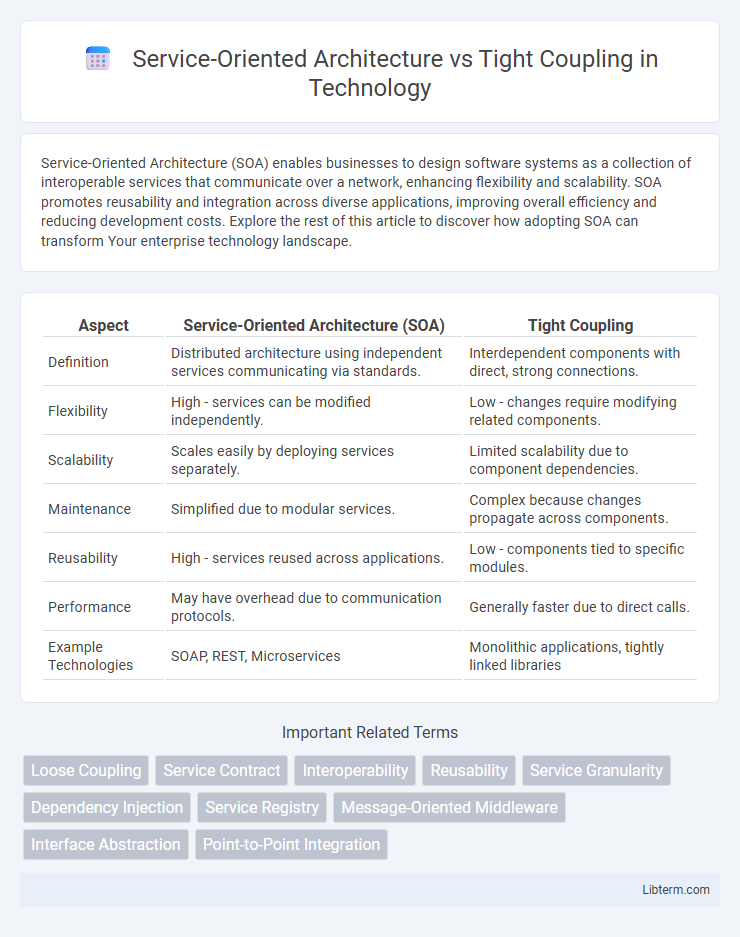Service-Oriented Architecture (SOA) enables businesses to design software systems as a collection of interoperable services that communicate over a network, enhancing flexibility and scalability. SOA promotes reusability and integration across diverse applications, improving overall efficiency and reducing development costs. Explore the rest of this article to discover how adopting SOA can transform Your enterprise technology landscape.
Table of Comparison
| Aspect | Service-Oriented Architecture (SOA) | Tight Coupling |
|---|---|---|
| Definition | Distributed architecture using independent services communicating via standards. | Interdependent components with direct, strong connections. |
| Flexibility | High - services can be modified independently. | Low - changes require modifying related components. |
| Scalability | Scales easily by deploying services separately. | Limited scalability due to component dependencies. |
| Maintenance | Simplified due to modular services. | Complex because changes propagate across components. |
| Reusability | High - services reused across applications. | Low - components tied to specific modules. |
| Performance | May have overhead due to communication protocols. | Generally faster due to direct calls. |
| Example Technologies | SOAP, REST, Microservices | Monolithic applications, tightly linked libraries |
Introduction to Service-Oriented Architecture (SOA)
Service-Oriented Architecture (SOA) is a design paradigm that structures software systems as a collection of interoperable services, promoting loose coupling and reusability across distributed environments. Unlike tight coupling where components are heavily dependent on each other, SOA enables autonomous services to communicate through standardized protocols such as SOAP or REST, enhancing scalability and flexibility. Implementing SOA reduces integration complexity and facilitates seamless business process automation by decoupling service functionality from specific applications.
Understanding Tight Coupling in Software Design
Tight coupling in software design occurs when components or modules are highly dependent on each other, leading to reduced flexibility and increased difficulty in maintenance or scalability. Unlike Service-Oriented Architecture (SOA), which promotes loose coupling through well-defined services and interfaces, tight coupling intertwines software elements, making updates or replacements risky and time-consuming. Understanding tight coupling is crucial for developers aiming to enhance modularity and responsiveness within a system by minimizing interdependencies.
Core Principles of SOA
Service-Oriented Architecture (SOA) emphasizes loose coupling, modularity, and reusability by designing services as independent, self-contained units that interact through standardized interfaces and protocols, unlike tight coupling which links components closely, making changes difficult and systems less flexible. Core principles of SOA include service abstraction, service autonomy, discoverability, and statelessness, which facilitate scalability and agility in enterprise applications. This architectural style enables seamless integration across heterogeneous systems, promoting agility and reducing dependency risks common in tightly coupled systems.
Characteristics of Tightly Coupled Systems
Tightly coupled systems exhibit high interdependence among components, resulting in limited modularity and inflexibility during maintenance or updates. These systems often require simultaneous changes across multiple modules, increasing the risk of cascading failures and reducing overall scalability. This rigid connectivity contrasts sharply with Service-Oriented Architecture's loosely coupled design, which enhances adaptability and easier integration.
Flexibility and Scalability Comparison
Service-Oriented Architecture (SOA) offers superior flexibility and scalability by enabling loosely coupled services that can be independently developed, deployed, and scaled based on demand. Tight coupling results in rigid systems where changes in one component often require modifications in others, limiting adaptability and hindering scalability. SOA's modular approach facilitates easier integration of new functionalities and dynamic resource allocation, enhancing operational efficiency in complex environments.
Interoperability in SOA vs Tight Coupling
Service-Oriented Architecture (SOA) enhances interoperability by enabling loosely coupled services that communicate through standardized protocols, allowing diverse systems to integrate seamlessly. In contrast, tight coupling creates strong dependencies between components, limiting flexibility and hindering interoperability across heterogeneous environments. SOA's emphasis on loosely coupled, reusable services fosters agility and easier integration compared to the rigid, intertwined nature of tightly coupled systems.
Maintainability and Upgradability: A Comparative Analysis
Service-Oriented Architecture (SOA) enhances maintainability and upgradability by decoupling services, allowing independent modifications without impacting the entire system. Tight coupling creates dependencies that complicate updates and increase risks during maintenance due to intertwined components. SOA's modular design supports scalability and agility, reducing downtime and accelerating the deployment of enhancements compared to tightly coupled architectures.
Performance and Latency Considerations
Service-Oriented Architecture (SOA) enhances system scalability and flexibility by decoupling services, which can reduce latency through optimized service interactions and load distribution. Tight coupling often leads to higher performance within a single application context due to direct method calls but may increase latency and complexity when integrating multiple components or scaling. Performance in SOA depends on network communication overhead, while tight coupling minimizes inter-component messaging delays but sacrifices modularity and adaptability.
Real-World Use Cases: When to Use SOA or Tight Coupling
Service-Oriented Architecture (SOA) excels in complex, large-scale enterprises requiring flexible, reusable services, such as multinational banks integrating diverse financial systems. Tight coupling is more suitable for small, performance-critical applications like embedded systems or real-time gaming where direct and fast interactions between components are essential. Choosing SOA enables scalability and independent service updates, while tight coupling offers simplicity and speed in tightly integrated environments.
Best Practices for Transitioning from Tight Coupling to SOA
Transitioning from tight coupling to Service-Oriented Architecture (SOA) requires decomposing monolithic applications into loosely coupled, reusable services that communicate through standardized interfaces such as RESTful APIs or SOAP. Emphasize identifying service boundaries based on business capabilities and employing middleware like Enterprise Service Bus (ESB) to facilitate integration and orchestration. Implementing best practices involves continuous refactoring, strengthening governance policies, and adopting domain-driven design to enhance scalability, maintainability, and agility.
Service-Oriented Architecture Infographic

 libterm.com
libterm.com